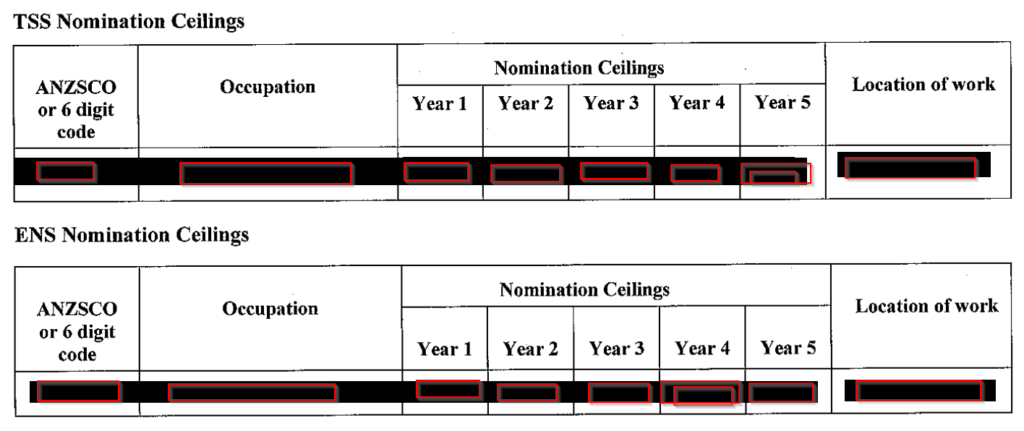A designated area migration agreement (DAMA) is an overarching labour agreement in place for a particular region of Australia. The process largely sits outside of a legislative framework, with most requirements outlined under policy only. It is a formal agreement between the Australian Government and a regional, state or territory authority. The South Australian Designated Area Migration Agreement (DAMA) is a formal agreement between the Australian Government, represented by the Department of Home Affairs and the South Australian Government, Department for Industry, Innovation and Science.
On this page
- Legislative Framework
- Diagram outlines the end-to-end process
- The South Australian Designated Area Migration Agreement (DAMA)
- SA DAMA occupations
- Nomination ceilings
01. Legislative Framework
A designated area migration agreement (DAMA) is an overarching labour agreement in place for a particular region of Australia. The process largely sits outside of a legislative framework, with most requirements outlined under policy only. It is a formal agreement between the Australian Government and a regional, state or territory authority.
Migration Act 1958 (the Act) and Migration Regulations 1994 (the Regulations) and associated administrative processes.
The Regulations do, however, set out the requirements that are required to be met where TSS, ENS or SESR nomination or visa applications are lodged under a labour agreement.
In addition, there are provisions in the Act and Regulations that define the terms ‘Work Agreement’ (WA) and ‘Labour Agreement’. The Regulations also include limited provisions regarding requirements for entering into a WA.
As outlined in Regulation 2.76, a Work Agreement is a type of LA. It must:
- be between:
- the Commonwealth, as represented by the Minister, or by the Minister and one or more other Ministers; and
- a person*, an unincorporated association or a partnership; and
- be a LA that authorises the recruitment, employment, or engagement of services of a person who is intended to be employed or engaged as a holder of a TSS visa; and
- be in effect (i.e. signed by all parties).
It provides access to more overseas workers than the standard skilled migration program. DAMAs operate under an agreement-based framework, providing flexibility for regions to respond to their unique economic and labour market conditions.
Individual DAMA labour agreements are between the Australian Government and endorsed employers/businesses operating within the relevant designated region. They:
- are generally in effect for five years, and
use the subclass 482 Temporary Skills Shortage (TSS), subclass 494 Skilled Employer Sponsored Regional (Provisional), and subclass 186 Employer Nominated Scheme (ENS) visa programs.
Application process and how to apply for the Northern Territory Designated Area Migration Agreement.
There are currently 12 DAMAs in place.
- Adelaide City Technology and Innovation Advancement, SA: Skilled & Business Migration
- East Kimberley, WA: East Kimberley Chamber of Commerce and Industry
- Far North Queensland, QLD: Cairns Chamber of Commerce
- Goulburn Valley, VIC: Goulburn Valley
- Great South Coast, VIC: Warrnambool City Council
- Northern Territory, NT: Northern Territory Designated Area Migration Agreement
- Orana, NSW: Regional Development Australia – Orana, NSW
- Pilbara, WA: RDA Pilbara
- South Australia Regional, SA: Skilled & Business Migration
- South West, WA: Shire of Dardanup
- The Goldfields, WA: City of Kalgoorlie Boulder
- Townsville, QLD: Townsville Enterprise Limited
02. The diagram outlines the end-to-end process
The following diagram outlines the end-to-end process for applying for this visa. An employer is required to seek endorsement.

03. The South Australian Designated Area Migration Agreement (DAMA)
The South Australian Government has entered into two DAMAs:
Adelaide Technology and Innovation Advancement Agreement
This agreement focuses on Adelaide’s high-tech growth industries including defence, space, technology and advanced manufacturing industries. The Adelaide City Technology and Innovation Advancement Agreement is the Designated Area Migration Agreement (DAMA) covering metropolitan Adelaide.

South Australian Regional Workforce Agreement
This agreement focuses on South Australia’s regional high growth industries including agribusiness, forestry, health and social services, tourism and hospitality, construction and mining. The South Australian Regional Workforce Agreement is the Designated Area Migration Agreement (DAMA) covering the entire state of South Australia.
04. SA DAMA occupations
05. Nomination ceilings
Agreement can include a ‘nomination ceiling’ –a maximum number of TSS and/or ENS nominations that can be approved in each year of an agreement for the next five years.
Ceiling numbers can be agreed upon ‘upfront’.
The Minister must authorise the DAMA agreement. For a DAMA to be approved, efforts must be demonstrated to recruit Australians; first, ceilings must be placed on the numbers of overseas workers employed annually.

Variation to ceiling numbers
Where a variation to ceiling numbers is needed, the sponsor is required to provide the following documentation to the Department so that they consider whether it is appropriate for a Deed of Variation to be prepared and executed:
- updated workforce plans;
- evidence of labour market testing that has been undertaken during the last 12 months;
- evidence of salary arrangements for, and amounts paid to, Primary Sponsored Persons;
- details of any breaches of immigration or other Commonwealth or State/Territory laws;
- the dates, numbers and occupations of any and all Australian workers who have been retrenched or made redundant in the past 12 month period; and
- any additional information requested by the Minister.
Variations to an LA cannot commence until a new written document is executed by or on behalf of all parties. Where a variation has been requested to increase nomination ceilings, nomination applications cannot be lodged until the Deed of Variation has been fully executed.
